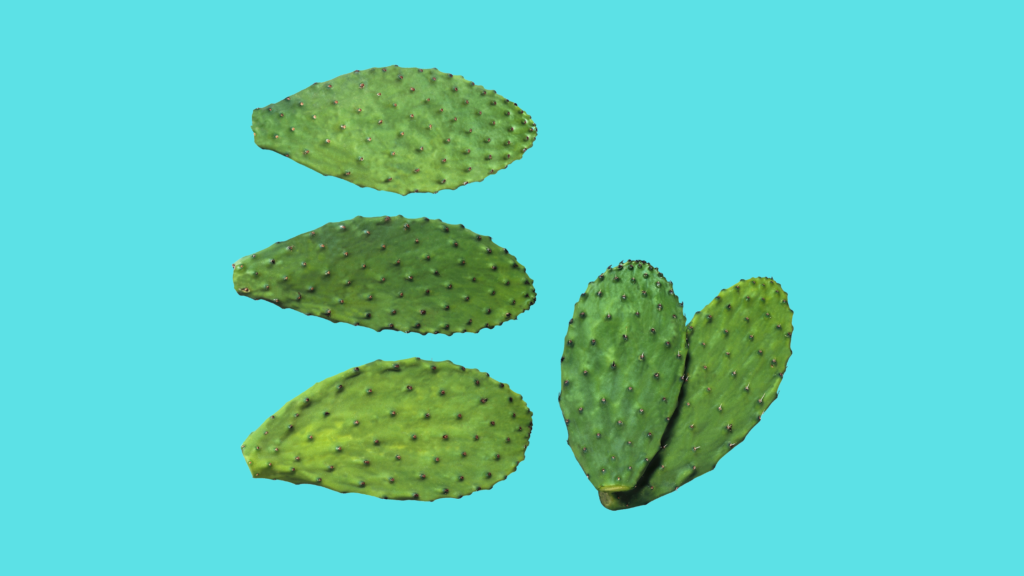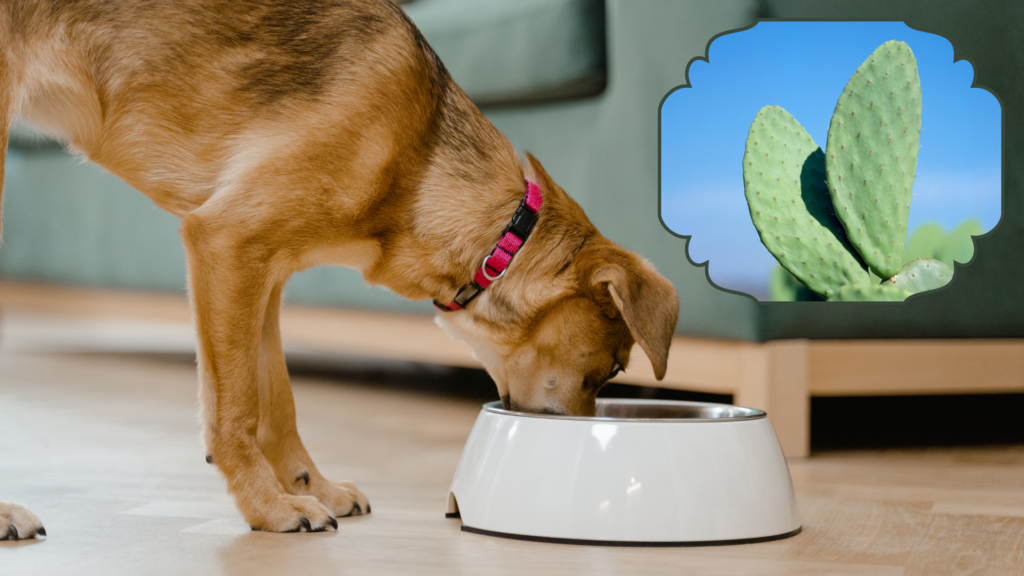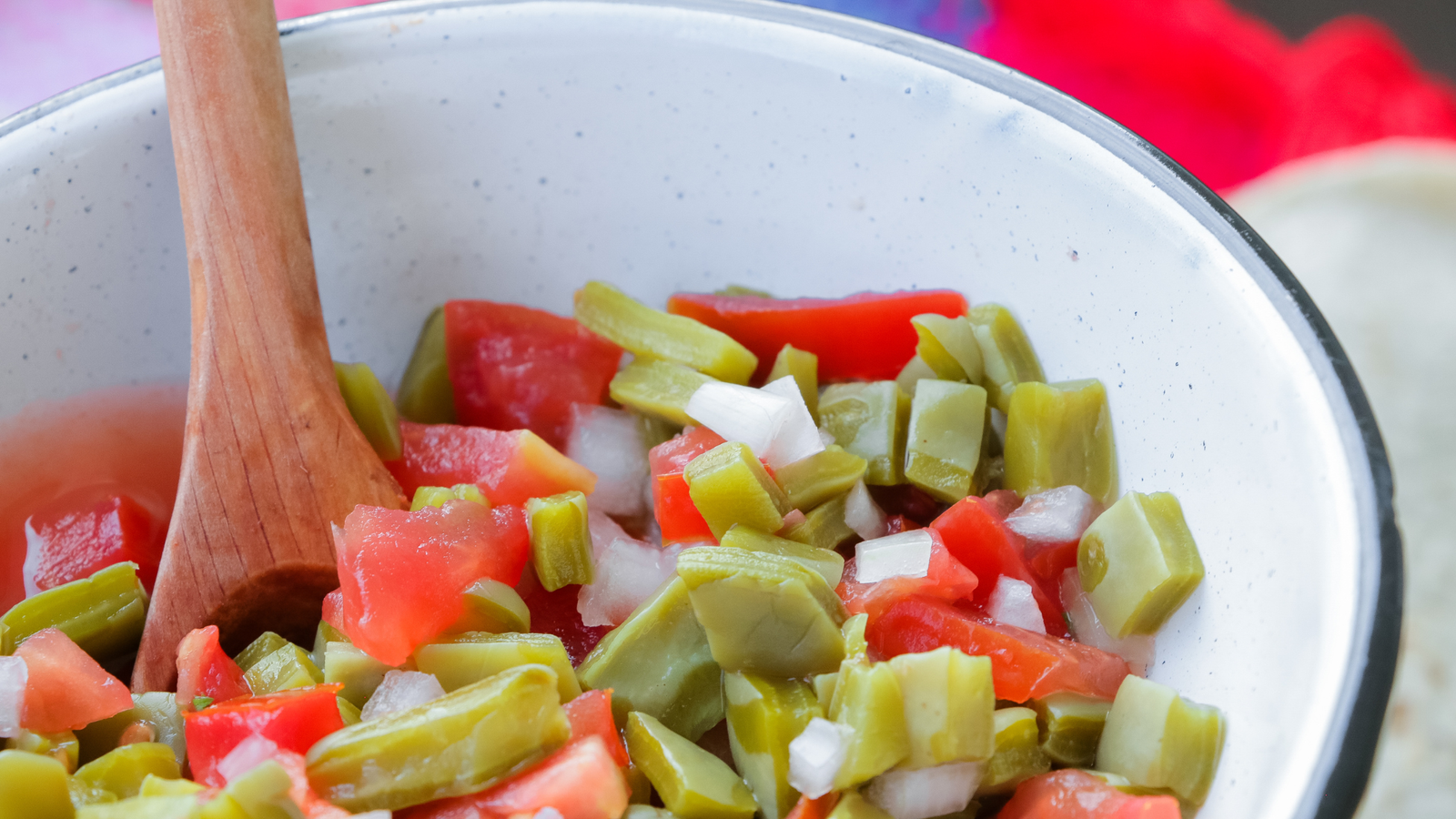Curious about incorporating nopales, the prickly pear cactus pads, into your dog’s diet? If you’ve wondered, “Can dogs eat nopales?” you’ve come to the right place.
This comprehensive guide will explore the benefits and risks of feeding nopales to your furry friend.
Discover how to safely introduce nopales into your dog’s meals and explore some delicious nopales recipes specifically designed for dogs.
Let’s dive into the world of nopales and see if they can be a nutritious addition to your dog’s diet.
What Are Nopales?

Picture a vibrant green and prickly plant standing tall in the arid regions of Mexico and Central America.
Meet nopales, the intriguing and versatile prickly pear cactus pads that have captured food enthusiasts’ hearts (and taste buds) worldwide.
Nopales are not your typical leafy greens. These thick, flat, and oval-shaped cactus pads offer a flavor best described as a delightful blend of green beans and peppers.
But don’t be fooled by their spiky appearance – those tiny spines are removed before they become onto your plate.
For centuries, nopales have played a vital role in the culinary traditions of Mexican and Central American cuisine.
They add a unique touch to dishes with their tangy and refreshing taste. Whether grilled, sautéed, boiled, or even enjoyed raw, nopales bring a distinctive flavor and texture to your meals.
However, nopales offer more than just culinary appeal. These prickly wonders have a long-standing reputation as a medicinal plants, treasured for their potential health benefits.
Packed with essential vitamins, minerals, antioxidants, and dietary fiber, nopales have caught the attention of health-conscious individuals seeking to enhance their well-being.
But what about our four-legged friends? Can dogs partake in the nopales goodness?
Are there potential benefits awaiting them, or should we proceed with caution? Let’s explore the truth about nopales and their compatibility with our furry companions.
Nutritional Value of Nopales
Regarding nopales, their unique flavor isn’t the only thing that makes them remarkable.
These prickly pear cactus pads boast an impressive nutritional profile, offering a range of vitamins, minerals, and other beneficial components.
Let’s take a closer look at the nutritional value of nopales:
1. Vitamins
Nopales are a great source of vitamins, particularly vitamin C.
Just 100 grams of nopales can provide a significant portion of your dog’s daily vitamin C requirements, which is crucial in supporting the immune system and overall health.
2. Minerals
Nopales are rich in essential minerals such as potassium, magnesium, and calcium.
Potassium helps maintain proper muscle and nerve function, while magnesium contributes to bone health and energy production.
Calcium is essential for strong teeth and bones.
3. Antioxidants
Nopales contain antioxidants, including flavonoids and betalains, which help combat harmful free radicals in the body.
Antioxidants contribute to overall cellular health and may have potential anti-inflammatory properties.
4. Dietary Fiber
Nopales are an excellent source of dietary fiber, which aids in digestion and promotes a healthy digestive system.
Fiber can also help regulate blood sugar levels and promote feelings of fullness, which may benefit dogs struggling with weight management.
5. Low in Calories
For dog owners mindful of their furry friend’s calorie intake, nopales can be a favorable addition to their diet.
These cactus pads are relatively low in calories, making them a nutritious option for dogs on weight management plans.
It’s important to note that while nopales offer an array of beneficial nutrients, they should not replace a balanced diet formulated for dogs.
Consult with your veterinarian to determine how nopales can fit into your dog’s overall nutrition plan and ensure it aligns with their dietary needs.
Now that we’ve explored nopales’ impressive nutritional value let’s move on to the burning question: Can dogs safely enjoy the goodness of nopales? Let’s find out in the next section.
Can Dogs Eat Nopales?

As a responsible pet owner, it’s natural to wonder whether nopales are safe for your furry companion to consume.
The good news is that, in general, dogs can indeed enjoy nopales as part of their diet.
However, there are a few considerations to keep in mind before introducing nopales to your dog’s meals:
1. Allergies and Sensitivities
Like humans, dogs can have allergies or sensitivities to certain foods.
While nopales are not considered a common allergen for dogs, observing your dog’s reaction when introducing them for the first time is essential.
Start with a small amount and monitor your dog for any signs of an adverse reaction, such as itching, vomiting, or diarrhea. If any unusual symptoms occur, discontinue feeding nopales and consult your veterinarian.
2. Spine Removal
The spines or thorns on nopales can pose a choking hazard or cause discomfort if ingested by your dog.
It’s crucial to thoroughly remove all spines before offering nopales to your furry friend. Peel the pads carefully and use a knife or vegetable brush to ensure no spines remain.
Take extra care to prevent any injuries to yourself while handling nopales.
3. Moderation and Balance
Nopales should be served to dogs in moderation, just like any new food.
While they offer various nutrients, they should complement a balanced diet rather than replace essential components.
Consult with your veterinarian to determine the appropriate amount of nopales to incorporate into your dog’s diet based on size, age, and overall health.
4. Preparing and Cooking
Nopales should be cooked before serving them to your dog.
Raw nopales may be challenging for dogs to digest and could potentially cause gastrointestinal issues.
Cooking methods such as boiling, steaming, or grilling nopales can help make them easier for your dog to consume and digest.
By considering these considerations, you can safely introduce nopales to your dog’s diet and potentially provide them with the nutritional benefits these cactus pads offer.
In the next section, we’ll explore the potential benefits that nopales can bring to your dog’s well-being.
Also Read: Can Bird Seed Kill a Dog? Exploring the Risks and Safety Measures
Benefits of Nopales for Dogs
Introducing nopales into your dog’s diet can offer a range of potential health benefits.
While further research specific to dogs is limited, the nutritional composition of nopales suggests several advantages.
Here are some potential benefits of incorporating nopales into your furry friend’s meals:
1. Nutrient Boost
Nopales are packed with essential vitamins, minerals, and antioxidants that can contribute to your dog’s overall health.
Vitamin C in nopales supports a robust immune system, while minerals like potassium and magnesium aid in proper muscle function and bone health.
2. Digestive Health
Nopales are an excellent dietary fiber source, promoting healthy digestion in dogs. Adequate fiber intake can support regular bowel movements and prevent constipation.
It may also help dogs with certain gastrointestinal conditions, such as sensitive stomachs or irritable bowel syndrome.
3. Hydration Support
Nopales have a high water content, which can help keep your dog hydrated, especially during warmer months or if they tend to be less inclined to drink water.
The additional hydration can contribute to overall well-being and proper bodily functions.
4. Weight Management
For dogs struggling with weight management, nopales can be a beneficial addition to their diet.
With their low-calorie and high-fiber content, nopales can help your dog feel full without consuming excessive calories.
This can assist in maintaining a healthy weight and preventing obesity-related health issues.
5. Antioxidant Properties
The antioxidants found in nopales, such as flavonoids and betalains, may help combat oxidative stress and inflammation in dogs.
These properties can contribute to overall cellular health and potentially support a healthy immune system.
While nopales offer potential benefits, it’s important to remember that every dog is unique.
Some dogs may experience more noticeable advantages from incorporating nopales into their diet, while others may not demonstrate significant changes.
Always observe your dog’s response and consult your veterinarian for personalized advice based on your dog’s specific health needs.
Now that we’ve explored the potential benefits, addressing the risks and precautions associated with feeding nopales to dogs is crucial.
Let’s continue to the next section for a comprehensive understanding.
Nopales Risks for Dogs
While nopales can offer various benefits to dogs, you must be aware of the potential risks and take necessary precautions when incorporating them into your furry friend’s diet.
Here are some considerations to keep in mind:
1. Allergic Reactions
Although rare, dogs can develop allergies to nopales.
Watch for any signs of an adverse reaction, such as itching, swelling, or digestive upset, when introducing nopales to your dog’s diet.
If you notice any unusual symptoms, discontinue feeding nopales and consult your veterinarian.
2. Spine Hazards
The spines or thorns on nopales can pose a risk to your dog if ingested.
Thoroughly remove all spines before offering nopales to your dog, ensuring no remnants could cause injury or choking.
3. Gastrointestinal Issues
Some dogs may experience digestive upset when consuming nopales, especially if introduced too quickly or in large quantities.
Start by offering small amounts of cooked nopales and observe your dog’s response.
If digestive issues occur, such as diarrhea or vomiting, reduce or eliminate nopales from their diet and consult with your veterinarian.
4. Pesticide Exposure
When purchasing nopales, opt for organic or pesticide-free options whenever possible.
Conventionally grown nopales may contain pesticide residues that could harm your dog.
Check with the supplier or grower to ensure the nopales are free from harmful chemicals.
5. Individual Sensitivities
Each dog is unique; some dogs may have individual sensitivities or intolerances to certain foods.
Monitor your dog’s response to nopales and consider their overall health and pre-existing conditions before introducing them into their diet.
It’s crucial to consult with your veterinarian before adding nopales to your dog’s diet, especially if your dog has specific dietary requirements or health concerns.
They can provide personalized guidance based on your dog’s needs and help you make informed decisions.
In the next section, we’ll discuss how to safely introduce nopales into your dog’s diet and provide some delicious recipes tailored specifically for our canine friends.
Adding Nopales to Your Dog’s Diet
When incorporating nopales into your dog’s diet, following proper guidelines and introducing them gradually is important.
Here’s a step-by-step approach to safely add nopales to your dog’s meals:
1. Consult with Your Veterinarian
Before making any dietary changes, consult with your veterinarian.
They can assess your dog’s needs, consider existing health conditions, and provide recommendations tailored to your furry friend.
2. Start with Small Amounts
Begin by offering a small amount of cooked nopales to your dog.
This allows you to monitor their response and ensure they tolerate it well. Observe for any signs of allergic reactions or digestive issues.
3. Prepare Nopales Safely
Thoroughly clean and remove all spines from the nopales before cooking.
Peel the pads carefully and use a knife or vegetable brush to ensure no spines remain.
Cooking methods such as boiling, steaming, or grilling nopales can make them easier for your dog to digest.
4. Monitor Your Dog’s Reaction
After introducing nopales into your dog’s diet, closely monitor their reaction.
Watch for any changes in appetite, behavior, or digestive patterns. If any negative symptoms occur, discontinue feeding nopales and consult your veterinarian.
5. Balance and Moderation
Nopales should complement a balanced diet for your dog.
They should not replace essential components or comprise a significant portion of their meals.
Work with your veterinarian to determine the appropriate amount of nopales based on your dog’s size, age, and overall health.
6. Consider Nopales as Treats or Toppers
Instead of making nopales the main component of your dog’s meals, consider using them as occasional treats or meal toppers.
This ensures that your dog receives a variety of nutrients from different sources.
Remember, every dog is unique, and what works well for one dog may not be suitable for another.
Pay attention to your dog’s needs and preferences when incorporating new foods.
To make the nopales more enticing for your dog, you can consider incorporating them into delicious recipes.
In the next section, we’ll explore some nopales recipes specifically designed for dogs, ensuring a tasty and nutritious dining experience.
Nopales Recipes for Dogs
If you’re looking to add some variety to your dog’s meals, here are a couple of nopales recipes that can make their dining experience both nutritious and enjoyable:
1. Grilled Nopales Delight
Ingredients:
– 2 nopales pads (thoroughly cleaned and spine-free)
– 1 tablespoon olive oil
Instructions:
1. Preheat the grill to medium heat.
2. Brush the nopales pads with olive oil, ensuring both sides are coated.
3. Place the nopales pads on the grill and cook for 5 minutes on each side or until slightly tender.
4. Remove from the grill and let them cool.
5. Cut the nopales into small, bite-sized pieces suitable for your dog’s consumption.
6. Serve as a standalone treat or mix it with your dog’s food for added flavor and nutrients.
2. Nopales and Chicken Stew
Ingredients:
– 1 boneless, skinless chicken breast
– 1 Nopales pad (cleaned and spine-free)
– 1 cup low-sodium chicken broth
– 1/2 cup diced carrots
– 1/2 cup diced sweet potatoes
Instructions:
1. Bring the chicken breast and broth to a boil in a saucepan. Reduce heat and simmer until the chicken is cooked thoroughly.
2. Remove the cooked chicken breast from the broth and shred it into small, manageable pieces.
3. Cut the nopales pad into small cubes.
4. Add the diced carrots, sweet potatoes, and nopales cubes to the chicken broth.
5. Cook the vegetables in the broth until they are tender.
6. Add the shredded chicken back to the pot and stir well.
7. Allow the stew to cool before serving it to your dog.
8. Serve an appropriate portion of the stew as a meal or mix it with your dog’s regular food for a delicious and nutritious twist.
Adjust the portion sizes according to your dog’s size, dietary needs, and consult your veterinarian for specific recommendations.
By incorporating these nopales recipes into your dog’s diet, you can provide them with a unique and healthy dining experience. Always monitor your dog’s response and make adjustments as needed.
Frequently Asked Questions (FAQs) About Dogs and Nopales
Can all dogs eat nopales?
While nopales are generally safe for dogs, some dogs may have allergies, sensitivities, or dietary restrictions. It’s important to introduce nopales gradually and monitor your dog’s response. Consult with your veterinarian before adding nopales to your dog’s diet, especially if your dog has specific health concerns.
How should nopales be prepared for dogs?
Nopales should be thoroughly cleaned, with all spines removed, before cooking. Peel the pads carefully and use a knife or vegetable brush to ensure no spines remain. Cooking methods such as boiling, steaming, or grilling can make nopales easier for dogs to digest.
Can dogs eat raw nopales?
It’s generally recommended to cook nopales before feeding them to dogs. Raw nopales may be challenging for dogs to digest and could potentially cause gastrointestinal issues. Cooking nopales can make them more palatable and safer for consumption.
How many nopales should I feed my dog?
The number of nopales to feed your dog depends on size, age, and overall health. It’s best to consult your veterinarian to determine the appropriate portion size for your dog. Nopales should complement a balanced diet rather than replace essential components.
What are the potential benefits of nopales for dogs?
Nopales can provide several potential benefits for dogs, including a nutrient boost, support for digestive health, hydration, weight management, and antioxidant properties. However, the specific benefits may vary from dog to dog, and observing your dog’s individual response is important.
Are there any risks associated with feeding nopales to dogs?
While nopales are generally safe, there are some risks to consider. Dogs may have allergies or sensitivities to nopales, and the spines can pose a choking hazard or cause discomfort if ingested. Some dogs may also experience gastrointestinal issues. It’s crucial to monitor your dog’s response and take necessary precautions.
Can puppies eat nopales?
Puppies have specific dietary needs, so it’s best to consult with your veterinarian before introducing nopales. Puppies may have more sensitive digestive systems, and their nutritional requirements differ from adult dogs. Your veterinarian can guide when and how to incorporate nopales into a puppy’s diet.
Remember, it’s always important to consult your veterinarian for personalized advice based on your dog’s needs and health conditions.
Also Read: The Power of Aggressive Dog Board and Train Programs
Conclusion
In conclusion, nopales can be a beneficial addition to your dog’s diet, offering a range of potential health benefits.
They are rich in vitamins, minerals, antioxidants, and dietary fiber, which can support immune function, digestion, hydration, weight management, and overall well-being.
When feeding nopales to your dog, it’s important to introduce them gradually, monitor their response, and ensure they are prepared safely, with all spines removed.
Consider nopales as treats or meal toppers rather than a replacement for essential components of their diet.
While nopales are generally safe for dogs, it’s essential to be aware of potential risks, such as allergies, spine hazards, gastrointestinal issues, and pesticide exposure.
Consult with your veterinarian before incorporating nopales into your dog’s diet, especially if your dog has specific dietary requirements or health concerns.
To make mealtimes enjoyable, you can try preparing nopales recipes such as Grilled Nopales Delight or Nopales and Chicken Stew.
These recipes provide a nutritious twist and can be a flavorful addition to your dog’s meals.
Always prioritize your dog’s individual needs and preferences when making dietary changes.
Observe their response, and if any adverse symptoms occur, discontinue feeding nopales and seek veterinary advice.
Remember, a well-balanced diet tailored to your dog’s needs is key to their overall health and happiness.
With the right approach, you can incorporate nopales into your dog’s diet and provide them with various nutrients and flavors.
Now that you have a comprehensive understanding of dogs and nopales, you can make informed decisions about adding this unique and nutritious ingredient to your furry friend’s meals.
